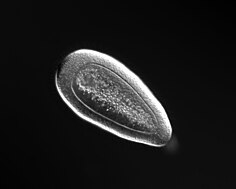A planula is the free-swimming, flattened, ciliated, bilaterally symmetric larval form of various cnidarian species and also in some species of Ctenophores, which are not related to cnidarians at all. Some groups of Nemerteans also produce larvae that are very similar to the planula, which are called planuliform larva. In a few cnidarian clades, like Aplanulata and the parasitic Myxozoa, the planula larval stage has been lost.
Development

The planula forms either from the fertilized egg of a medusa, as is the case in scyphozoans and some hydrozoans, or from a polyp, as in the case of anthozoans.
Depending on the species, the planula either metamorphoses directly into a free-swimming, miniature version of the mobile adult form, or navigates through the water until it reaches a hard substrate (many may prefer specific substrates) where it anchors and grows into a polyp. The miniature-adult types include many open-ocean scyphozoans. The attaching types include all anthozoans with a planula stage, many coastal scyphozoans, and some hydrozoans.
Feeding and locomotion
The planulae of the subphylum Medusozoa have no mouth, and no digestive tract, and are unable to feed themselves (lecithotrophic), while those of Anthozoa show more variation and can be both lecithotrophic, parasitic or feed on plankton or detritus.
Planula larvae swim with the aboral end (the end opposite the mouth) in front.
References
- ^ Ruppert EE, Fox RS, Barnes RD (2004). "Nemertea". Invertebrate Zoology (7 ed.). Brooks / Cole. pp. 271–274. ISBN 0-03-025982-7.
- Maslakova, Svetlana A. (2010-07-19). "Invention of the Pilidium Larva in an Otherwise Perfectly Good Spiralian Phylum Nemertea". Integrative and Comparative Biology. 50 (5): 734–743. doi:10.1093/icb/icq096. ISSN 1540-7063. PMID 21558236. Retrieved 2022-02-03.
- Nawrocki, A. M.; Cartwright, P. (2013). "Expression of WNT pathway genes in polyps and medusa-like structures of Ectopleura larynx (Cnidaria: Hydrozoa)". Evolution & Development. 15 (5): 373–384. doi:10.1111/ede.12045. PMID 24074282. S2CID 5337426.
- Uspenskaia, A. V.; Raĭkova, E. V. (2001). "Cytological aspects of similarity and difference of Myxozoa and Cnidaria". Tsitologiia. 43 (3): 284–309. PMID 11387759.
- ^ Nakanishi, Nagayasu; Yuan, David; Jacobs, David K.; Hartenstein, Volker (2008). "Early development, pattern, and reorganization of the planula nervous system in Aurelia (Cnidaria, Scyphozoa)". Development Genes and Evolution. 218 (10): 511–524. doi:10.1007/s00427-008-0239-7. PMID 18850237. S2CID 16969737.
- Manuel, R. L. (14 December 2023). British Anthozoa (Coelenterata: Octocorallia and Hexacorallia): Keys and Notes for the Identification of the Species. BRILL. ISBN 978-90-04-62754-3.
- Malakhov, V. V.; Bogomolova, E. V.; Kuzmina, T. V.; Temereva, E. N. (2019). "Evolution of Metazoan Life Cycles and the Origin of Pelagic Larvae". Russian Journal of Developmental Biology. 50 (6): 303–316. doi:10.1134/S1062360419060043.
This developmental biology article is a stub. You can help Misplaced Pages by expanding it. |
This cnidarian-related article is a stub. You can help Misplaced Pages by expanding it. |